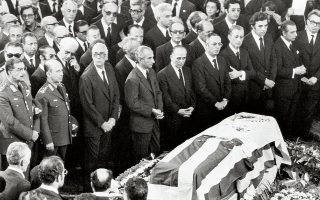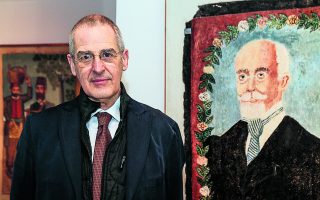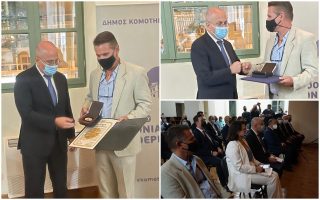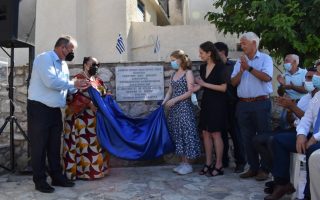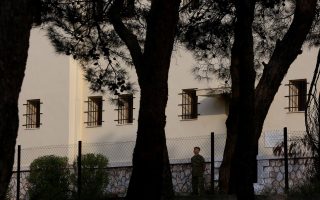The digital traces of the Greek uprooting
Study aims to map the movement of refugees and their distribution across the motherland in the wake of the 1922 Asia Minor disaster
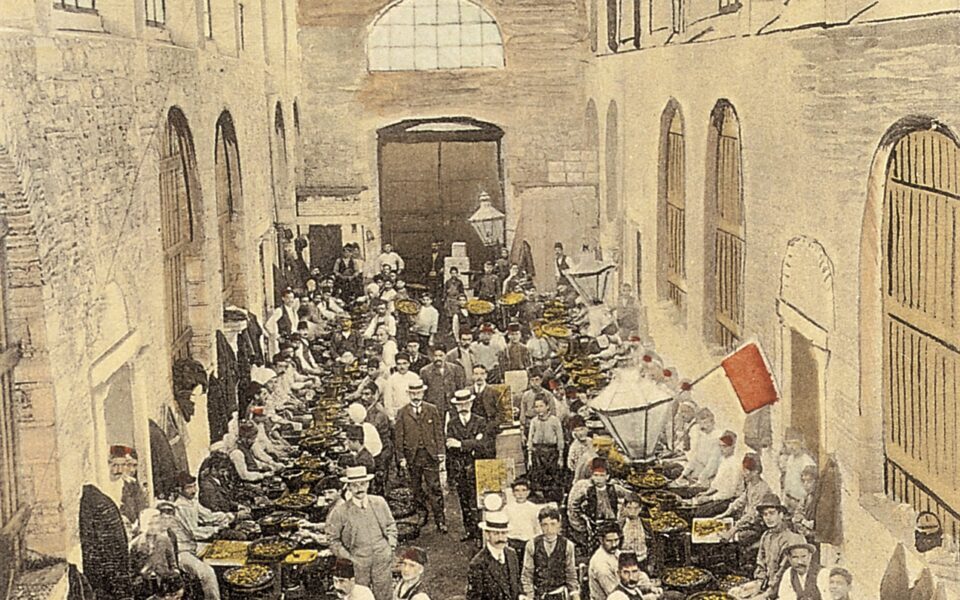
In 1922, Giannis Soumelidis received information from a friend enlisted in the Turkish Army. The content of this message and its exact date remain unknown but, acting on the information, Soumelidis and his family abandoned their work as innkeepers at Larachani in the Pontus region and moved away. They traveled 50 kilometers from their village, today known as Akarsu, to reach the coastal city of Trebizond (Trabzon) and boarded a ship bound for Thessaloniki.
“They were kept there in quarantine for a few months and later left for Rodochori, near the city of Naoussa. According to the Refugee Settlement Commission, Rodochori was chosen for settlement as its mountainous terrain was reminiscent of their homeland,” we are told by 22-year-old Zoi Soumelidou, a student at the University of Ioannina’s Department of Economics, who shared the story of her family.
Many kilometers south of Larachani, in the village of Sati in Cappadocia, Athanasios Andreou also abandoned his home and set out on a long trip, aged only 25. From Cappadocia he traveled to Argentina, before finally arriving in Greece and settling down in Neos Milotopos, near the city of Giannitsa. He was granted some arable land and continued working the fields as he had done in Cappadocia. At some point, “Athanasios” turned into “Andreas,” and he changed his surname to “Papadopoulos.”
“I do not know why he changed his surname, but I want to know more,” says Dimitra Papadopoulou, a student at the same University of Ioannina department and a descendent of the Andreou family on her father’s side. Her mother’s family were also refugees, as her great-grandfather Konstantinos Tsompanoglou moved to Greece from Kallipolis (Gallipoli) in Asia Minor. She grew up hearing her grandmother’s stories describing how difficult life and surviving were during their first years in Greece.
One of the few things that her great-grandmother brought with her from Kallipolis was an icon of St Constantine and St Helen that has been in her family for five generations. “When I was younger, I did not find them very interesting, but I now realize the importance of these stories,” says the 20-year-old student.
Out of a total of 867,000 recorded inhabitants in the 1928 census, 31.3% are from a refugee background. The Attica refugees account for 22.2% of the total number of people who arrived in Greece
This motivated her to participate in a large research project being carried out by the University of Ioannina that hopes to create a digital representation of the first major population exchange of the 20th century. Its goal is to provide a clear picture of where the refugees who arrived in Greece following the Asia Minor Campaign and the population exchange in 1923 were traveling from and where they settled.
Dimitra Papadopoulou contributes by gathering information to enrich the large databases created by the University of Ioannina’s Applied Informatics and Computational Economics Lab, with the names and journeys of over 600,000 urban and agricultural worker refugees. Her interest in exploring her family’s history is what pushed Zoi Soumelidou to be a part of the project. She identifies and records the villages in Anatolia from which refugees were uprooted not with a pin on a map, but with their exact geospatial coordinates.
The two undergraduates are part of a larger team of students led by the Lab’s director and associate professor of computational simulation, Thanassis Stavrakoudis. “If we view the project as a ship, we are the engineering officers,” he says metaphorically. His team compiles the databases by digitizing the refugee registers and lists that have been tracked down in various public historical archives that link the refugees with their communities of origin, as recorded in the 1928 census, with the communities today. One of the project’s missions is to create a website where users will be able to trace the journeys of refugees.
The data collected by the University of Ioannina team are analyzed and interpreted by project coordinator and lead Stelios Michalopoulos, professor of economics at Brown University. During our video call, Michalopoulos recalled that the history taught in schools concluded with the Asia Minor Campaign, but he notes that we do not have the hard facts and data about the contribution of the refugees to the political, economic and cultural history of Greece. “It is almost like there is a network with the stories of the refugees but there are no hinges to connect them. I hope our research will create the hinges to bring together all these social cells,” he says.
Since 2017, when researchers first started trawling through thousands of pages and registers (primarily handwritten ones), the project has largely recorded and digitized the two largest groups that arrived in Greece, agricultural worker and urban refugees. Michalopoulos states they have completed the digitalization of all agricultural worker refugees, recording for the first time all their 1,754 towns and cities of origin in Anatolia.
“For the first time, we have a full and detailed recording of all areas of origin. As evidenced, refugees from the Pontus region and Eastern Thrace received more allotments of arable land than the refugees originating from the coastal areas of Asia Minor. The latter group primarily settled in cities, usually on the fringe of the urban network. Refugees from Cappadocia seem to have divided equally between cities and rural areas,” he notes.
The project has also made a very interesting finding relating to the settlement conditions of urban refugees. When digitizing the census conducted by the Refugee Settlement Commission in 1927, located in the historical archive of the League of Nations in Geneva, researchers were able to record the high proportion of families living in shantytowns.
Indicatively, out of 124,483 refugee families included in the census, only 18% lived in rented homes (no addresses were recorded). Out of the remaining 101,406 families, 39% lived in Type A accommodation, considered “sanitary and adequate.” However, 50% of all urban refugees, almost 62,000 families, lived in Type B and Type C accommodation. They included “wooden shacks of questionable structural integrity,” and “derelict houses, tents, sheet metal shacks, abandoned public buildings, prisons, mosques, schools and churches.”
Exactly when the living conditions of refugees improved is unclear as there was never another census like the one in 1928. “It was still a pressing issue in the 1930s, even if the situation was slightly improved, and it continued to be a problem in certain areas of larger cities even after the Second World War,” we are told by Elias Papaioannou, professor of economics at the London Business School and project collaborator.
Attica and the Peloponnese
According to the researchers, most refugees settled in Attica. Out of a total of 867,000 recorded inhabitants in the 1928 census, 31.3% are from a refugee background. The Attica refugees account for 22.2% of the total number of people who arrived in Greece. According to the same census, the Peloponnese received the lowest number of refugees, while the Viannos area on the island of Crete reported just two refugees.
Did the refugees stay in the areas where they first settled? Empirical evidence seems to suggest that they did. Both Giannis Soumelidis and Athanasios Andreou lived out the rest of their lives in the areas they initially settled when they arrived in Greece. Zoi Soumelidou lives with her family in Edessa, a very short distance from Rodochori, and Dimitra Papadopoulou and her family still live in Neos Milotopos. However, it is truly very hard to come up with a definitive answer to the question, as Michalopoulos points out that the last census of the Greek state that included questions on the background of refugees was that carried out in 1928.
However, when researchers analyzed the data collected by the 2001 census – which included a question on the permanent address of one’s mother at the time of their birth, allowing for the isolation of those born before 1923 and who replied to the question with Turkey – they saw that, despite mass movements of populations and the 70 elapsed years, the impact of refugee settlement was still significant.
Impact on local politics, economy
Today, about 84 million people are living in a state of forcible displacement, according to the United Nations High Commissioner for Refugees. They have abandoned their homes due to persecution, war, violence and human rights violations. Michalopoulos is certain that this wave of movement will only grow in the future, and he believes that studying the impact of the 1922 refugees on the political and economic history of Greece can provide important lessons for the future.
Contained in 30 boxes originating from the Agriculture Ministry, found in the General State Archives, there is information on the livelihoods left behind by the refugees when they moved to Greece. The approximately 4,000 handwritten documents detail the claims submitted by refugees listing their houses and land in Anatolia, the agricultural income they were deprived of, their furniture, jewelry, tools, and animals they were forced to abandon. Their value was declared in pounds by the refugees and a committee noted their own estimate.
“A momentous effort is required to digitize this volume of data,” states Michalopoulos. Part of this effort was done by the Ecumenical Federation of Constantinopolitans, which photographed the entirety of the archive (almost a million pages), but funds are a necessary component of its continued digitalization.
However, a finding that illustrates the investment of refugees in their human capital was the high level of literacy in agricultural areas. Data show that the vast difference between refugees and natives was quickly bridged in the early years, as early as first-generation refugees. “In fact, after the Second World War, refugee villages outpaced neighboring native villages when it came to their percentage of high school graduates,” says Michalopoulos.
“This trend is very interesting for international scholarship as, similar to other cases, it seems that refugees who lost their livelihoods turned to their human capital,” states Michalopoulos. These same areas also record an increase of employment in craftwork industries, particularly cloth and textile manufacturing in the years following the Greek Civil War.
By the end of the centenary of the Asia Minor Campaign, researchers will be able to provide answers to three important questions. The first question concerns the contributions of the refugees to the structural reshaping of urban economies, the second focuses on the contribution of refugees to Greek music and the extent to which composers from refugee communities differentiated their thematic focus (did refugee songs refer more often to emigration and leaving one’s home?), and finally the political identity of refugee areas.
It is widely known that the refugees politically supported Eleftherios Venizelos and his Liberal Party until 1930, but the results of the 1932 election (which Venizelos lost) illustrated a change in Greek political life. However, the study shows that the large urban refugee centers in Athens, Piraeus and Thessaloniki supported Venizelos in the 1932 elections despite the treaties of rapprochement signed with Turkey in 1930. Researchers digitized and compared the results from electoral districts, found in contemporary newspapers, and saw that the votes garnered by the royalist People’s Party led by Panagis Tsaldaris in refugee neighborhoods dropped from the national average of 40% to 10% while the electoral share of Venizelos’ Liberal Party shot up from approximately 40% to over 60%.
“Where do the refugee votes go following the fall of Venizelism? Does a distinct ‘refugee’ political voting profile continue to exist today? If this is the case, why does this happen? These are the questions we are currently working on,” say Michalopoulos and Papaioannou.
Also participating in the project are Seyhun Sakalli, assistant professor in economics at King’s College London, Elie Murard, assistant professor in economics at the University of Alicante, Nikos Benos, associate professor of economics at the University of Ioannina, and Stelios Karagiannis, researcher at the European Commission.
